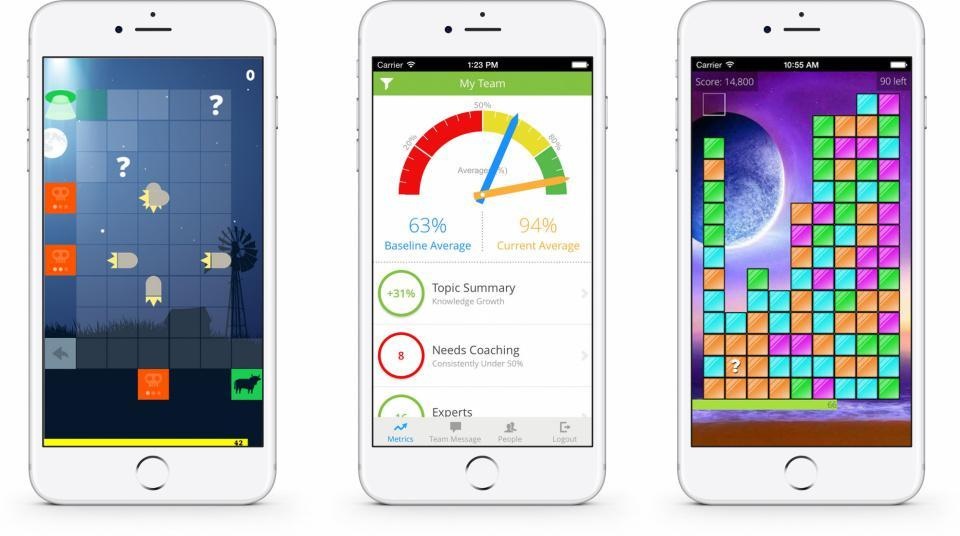Introducing Adaptive Learning: 3 essentials you need to know

If you’re considering adaptive learning for your employees there are three key areas to get up to speed with: the theory, the technology and the brain science.
Understanding the basics will give you a head start on using this ingenious approach to build employee knowledge more efficiently and in line with your business objectives. So let me take you through an overview of adaptive learning. It’s just five minutes that could change your approach to knowledge building forever.
What is adaptive learning?
Adaptive learning is linked to personalised learning but they are not the same thing.
Personalised learning is the starting point. L&D teams and managers have a key role to play here, in helping to compile each employee’s knowledge baseline through a ‘this is where you’re at now’ test at the outset. The next stage is to design the personalisation according to the employee’s own particular circumstances. This would take into account factors such as their department, function, location, responsibilities, attributes and knowledge levels, which you now know because of the baseline test. It’s this personalisation stage that filters out learning that’s not relevant to the individual.
Adaptive learning takes things a step further. It uses a data-driven algorithm to evaluate progress as the employee is undertaking the learning. Focusing on the individual’s circumstances, the algorithm looks at how far they’ve journeyed, compared to the initial benchmark. It then adapts the learning path during the learning process to ensure it meets their requirements. In this way, adaptive learning identifies and fills knowledge gaps along the way.
Adaptive learning therefore recognises that each employee is unique and experiences his or her own learning journey in their individual way. Why would you stick all your staff on the same bus and point them in the same direction? Even if the destination point is the same, how they get there isn’t.
Adaptive learning reaches new heights
Adaptive learning isn’t new. What is new, however, is the way that it has itself adapted to the point that we’ve reached now. Technology and what we know about brain science have combined to offer an intelligent, agile form of learning that we’ve never had before.
The Axonify platform brings together brain science, adaptive learning technology and engaging tools such as quizzes, gamification and scoreboards to provide ongoing learning.
Axonify is based on brain science research – what’s been shown to increase long-term knowledge absorption. These techniques include repeated retrieval (the testing effect), the spacing effect (interval reinforcement), chunking (bite-sized content) and confidence-based learning. Short bursts of relevant knowledge, every day, delivered in a targeted yet fun and engaging manner increases knowledge absorption and retention so the workers can use it on the job.
Knowing the science is one thing; translating it into a tool that delivers personalised, adaptive learning to employees is another. The Axonify platform achieves just this in a user-friendly package that is helping deliver real results for some of the world’s biggest brands.
Axonify provides customised microlearning content, tailored for each employee based on their particular personalised and adaptive learning factors. So although it can be delivered organisation-wide 24/7 through devices and desktops, the knowledge it provides to each individual is designed solely for them. Axonify does this by continually evaluating each learner’s progress from the initial baseline and adapting the learning path accordingly. In this way, it provides constant feedback to the learner.

The content might be questions, a quiz or a learning game. Prizes or points might be offered as a competitive incentive. Gamification is often also a key element because to be as effective as possible, learners have to want to learn; they need to enjoy it. Again, we know this from the proven brain science.
A word here about the content: although it is designed to increase each employee’s knowledge, this knowledge is 100% aligned to business results. Even before your employees start the training, the business goals have been firmly established. It’s from this foundation that each individual’s adaptive learning is built.
Which brings us to the next question: How do you know if the knowledge they’re receiving is actually hitting the spot and impacting on your business results? It’s the age-old workplace training conundrum that’s troubled employers for as long as any of us can remember. Finally, technology has the answer; Axonify’s in-built measuring tools enable employers to co-relate the development of their staff with business results.
How does it work in practice?
So that’s the theory, the science and technology explained in a nutshell. But how does adaptive learning actually work?
Let’s make things a little more personal and adaptive for you by looking at how it might work for your organisation. You have two staff members who need to increase their knowledge in order for you to improve results in a particular area of your business. After taking baseline tests, you establish they both need to start at Level One. After completing the first level, one employee has raced ahead and achieved the pass score. He moves on to other learning. His colleague, however, falls short and has to try again. But instead of him having to go through the entire test again, Axonify’s technology has worked out which areas he’s proficient in and those areas where he needs additional support. Axonify therefore adapts the learning and includes in knowledge targeted at the topics where the employee feels challenged. In his blog, JD Dillon, Principal Learning Strategist at Axonify, refers to this as the “assess and react” element. The technology constantly monitors the learner’s response to questions and other content until he attains the mandatory pass score.
The upshot is that each employee has attained the same knowledge – knowledge that ties in with your pre-determined business goals. Result!